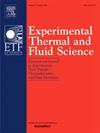Morphing evaporative heat and mass transport of nanofluid droplets by electric field
IF 2.8
2区 工程技术
Q2 ENGINEERING, MECHANICAL
Experimental Thermal and Fluid Science
Pub Date : 2024-12-18
DOI:10.1016/j.expthermflusci.2024.111399
引用次数: 0
Abstract
In this research, evaporation behaviour of pendant droplets of stable nanocolloidal dispersions in the presence of an electric field is probed, both experimentally and theoretically. It is observed that the colloid droplets evaporate faster than their water counterparts in absence of the field. But within field environment, increase of electric field strength suppresses the evaporation rates, while the field frequency shows no appreciable effects on the evaporation rates. Also, the reduction of evaporation rate in field environment is pronounced at higher colloidal concentrations. Theoretical analyses from existing models reveal that neither alterations in the surface tension nor the diffusion-driven classical evaporation model can map the reduced evaporation rates. Through infrared thermography and Particle Image Velocimetry, reduction of internal thermo-solutal circulation velocity for the droplet is noted when stimulated by the electric field, which is shown to directly affect the rate of evaporation. The effects of electrohydrodynamic advection, electro-thermal and electro-solutal convection on the evaporation behaviour is modelled by a scaling approach. The influence of dominant non-dimensional numbers, such as thermal Marangoni number, solutal Marangoni number, electro-Prandtl number, electro-Schmidt number, and the Electrohydrodynamic number, are quantified and discussed. Stability considerations reveal that the stable internal flow behaviour is retarded by the electric body force, with the reduction via the electro-solutal route being predominant, and the internal flow velocities being mapped well by the electro-solutal model. The findings may hold implications in the domain of multiphase transport phenomena of complex fluids at micro and macroscales.
电场作用下纳米液滴蒸发热和质量输运的变形
在本研究中,从实验和理论两方面探讨了稳定纳米胶体分散体悬垂液滴在电场存在下的蒸发行为。我们观察到,在没有电场的情况下,胶体液滴的蒸发速度比水的蒸发速度快。但在电场环境下,电场强度的增加抑制了蒸发速率,而电场频率对蒸发速率的影响不明显。此外,在田间环境中,较高的胶体浓度显著降低了蒸发速率。现有模型的理论分析表明,无论是表面张力的变化还是扩散驱动的经典蒸发模型都不能反映蒸发速率的降低。通过红外热像仪和粒子成像测速,发现电场刺激下液滴内部热溶质循环速度降低,直接影响蒸发速率。采用标度法模拟了电流体动力对流、电热对流和电溶质对流对蒸发行为的影响。讨论了热Marangoni数、溶质Marangoni数、电-普朗特数、电-施密特数、电-水动力数等非量纲数的影响。稳定性方面的考虑表明,稳定的内部流动行为被电体力延缓,通过电溶质途径的减少是主要的,并且内部流动速度被电溶质模型很好地映射出来。研究结果对复杂流体的微观和宏观多相输运现象具有一定的指导意义。
本文章由计算机程序翻译,如有差异,请以英文原文为准。
求助全文
约1分钟内获得全文
求助全文
来源期刊

Experimental Thermal and Fluid Science
工程技术-工程:机械
CiteScore
6.70
自引率
3.10%
发文量
159
审稿时长
34 days
期刊介绍:
Experimental Thermal and Fluid Science provides a forum for research emphasizing experimental work that enhances fundamental understanding of heat transfer, thermodynamics, and fluid mechanics. In addition to the principal areas of research, the journal covers research results in related fields, including combined heat and mass transfer, flows with phase transition, micro- and nano-scale systems, multiphase flow, combustion, radiative transfer, porous media, cryogenics, turbulence, and novel experimental techniques.
 求助内容:
求助内容: 应助结果提醒方式:
应助结果提醒方式:


